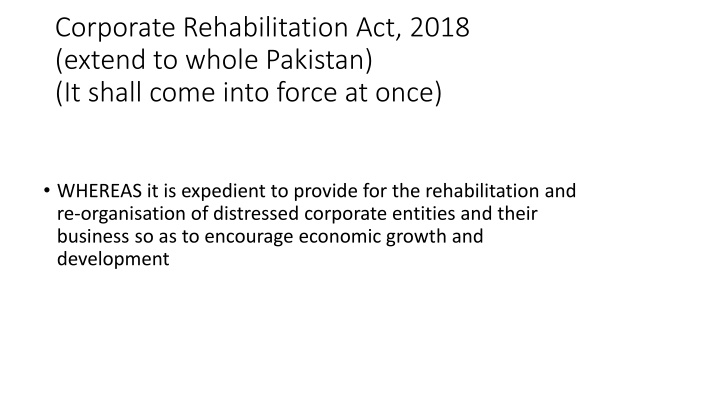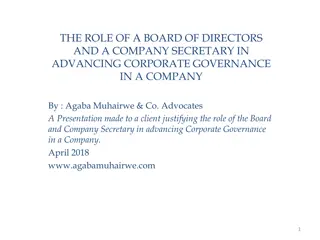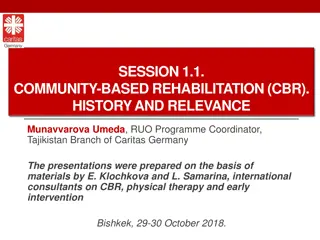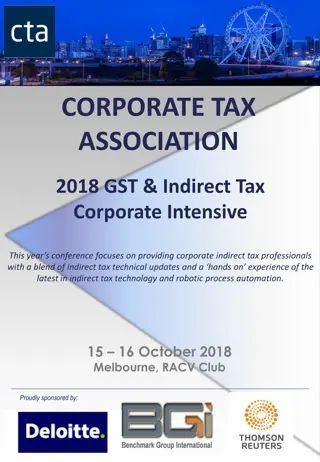Corporate Rehabilitation Act, 2018: A Comprehensive Overview
The Corporate Rehabilitation Act, 2018 aims to facilitate the recovery and restructuring of financially troubled corporate entities in Pakistan. It emphasizes the importance of revitalizing distressed businesses to foster economic growth and development. The Act defines key terms and outlines the roles of various stakeholders, including administrators, creditors, debtors, and insolvency experts. It also details the jurisdiction and powers of the High Court in overseeing corporate rehabilitation proceedings, including provisions for appeals and reviews.
Download Presentation

Please find below an Image/Link to download the presentation.
The content on the website is provided AS IS for your information and personal use only. It may not be sold, licensed, or shared on other websites without obtaining consent from the author.If you encounter any issues during the download, it is possible that the publisher has removed the file from their server.
You are allowed to download the files provided on this website for personal or commercial use, subject to the condition that they are used lawfully. All files are the property of their respective owners.
The content on the website is provided AS IS for your information and personal use only. It may not be sold, licensed, or shared on other websites without obtaining consent from the author.
E N D
Presentation Transcript
Corporate Rehabilitation Act, 2018 (extend to whole Pakistan) (It shall come into force at once) WHEREAS it is expedient to provide for the rehabilitation and re-organisation of distressed corporate entities and their business so as to encourage economic growth and development
Definitions (2). (1 of 2) Administrator: appointed under section 20 administration committee: committee of the creditors or shareholders of the debtor appointed under section 26 claim/debt: right to payment (includes principal amount and any mark-up, profit, return and other charges) Commission: SECP Court: High Court Creditor: entity that has a claim against debtor Debtor: company specified under section 6 Financial institution: as per the Financial Institutions (Recovery of Finances) Ordinance, 2001 insolvency expert: as defined in section 5
Definitions (2). (2 of 2) Interest or class of interests: Person or class of persons liable to contribute to the assets of a company in case of winding up Mediator: appointed under section 10 Ordinance: Companies Ordinance, 2016 (VI of 2016) or such other law in force for regulations of companies order of mediation: passed by the Court under section 10 plan of rehabilitation: as per section 7 Prescribed: rules or regulations made under this Act Property: Property of all description qualifying creditors: one or more creditors having claims for an aggregate amount of not less than two-third of the value of assets of the debtor as per its latest balance sheet Rules / Regulations: Made under this act security interest: a charge, mortgage, lien, hypothecation, pledge, assignment or any other encumbrance over a property State Bank: State Bank of Pakistan Act, 1956 statement of affairs: means statement of particulars about the property and business of a debtor prepared under section 9.
Jurisdiction and powers of High Court (3) High Court having jurisdiction over the place at which the registered office (or principal business) of the debtor is situated. the Court shall: exercise its civil jurisdiction in exercise of its criminal jurisdiction, have all the powers of Code of Criminal Procedure, 1898 exercise of its company jurisdiction, under the companies ordinance or act. Notwithstanding anything contained in any other law shall be disposed of expeditiously (except in extraordinary circumstances) Appeal and review(4): same procedure like original civil jurisdiction. The court may review, rescind or vary any order
Insolvency experts (5): Commission shall (with SBP consultation) maintain a panel of experts (having minimum 15 years experience accountancy, banking, finance, law, management and knowledge of Insolvency) He will entitled to remunerations and privileges. entitled to remunerations and privileges as per rule. Commission may prescribe code of conduct for the panel
Debtor (6) : incorporated or registered company EXCEPT: a financial institution Insurance Companies Whoes debts are less than specified amount (nowadays hundred million Rupees) order of dismissal under section 17 has been passed within the past five years. winding up order has already been passed. company which has resolved by special resolution that such company be wound up voluntarily. company against which execution proceedings are pending for satisfaction of one or more decrees for an aggregate sum not less than twenty-five percent of the value of its asset. a company which has availed relief under the BPD Circular No. 29 of 2002 issued by the State Bank.
Plan of rehabilitation (7): Shall specify: 1. a) claims and classes of claims against the debtor; (b) interests and classes of interests in the debtor; c) claims and interests belonging to the debtor; d) claims or interests that will not be impaired under the plan of rehabilitation; e) claims or interests that will be impaired under the plan of rehabilitation; f) places of business of the debtor, details of its assets and any security interests created over such assets; g) particulars of shareholders, directors and key management of the debtor; a h) scheme of implementation of t plan of rehabilitation of the debtor
Subject to sub-section (1), a plan of rehabilitation may provide for the following matters, in relation to a debtor the settlement, restructuring or rescheduling of any claims or interests or classes of claims or interests the change of ownership and management of the debtor the sale of all or any assets of the debtor and the distribution of proceeds of such sale among holders of claims or interests the assumption, rejection or assignment of any executory contract or unexpired lease of the debtor the enforcement of any claims or interests belonging to the debtor; and any other matter concerning rehabilitation of the debtor or distribution of proceeds of sale of property of the debtor.
Commencement of a case (8): 1. A debtor may file a petition in the Court supported by plan of rehabilitation and special resolution. 2. The qualifying creditors may file a petition in the Court 3. On first date of hearing, the Court shall issue notice to the parties (through registered post, courier service and English language and one Urdu language daily newspaper). 4. specify a date of hearing not later than twenty-one days after completion of the service. 5. Any person interested of filing a written reply: do so at least three days prior to the hearing (send copy to the other party) 6. The court may direct: 1. The debtor to submit statement of affair to the court within 15 days 2. The qualifying creditors a plan of rehabilitation of debter within 30 days after the statement of affair.
Statement of affairs(9): verified by the CEO/director of debtor on affidavit and contain: the assets, debts and liabilities of the debtor; Particulars of the creditors (stating amount, security and dates etc) debts due to the debtor (along with detail from debts are due) and amount likely to be realized. In case property is not in possession, specify place or person whoses possession is. Addresses of the business, where business in conducted. Detail of debtor of pending proceedings Any other, prescribed by the law Failing to do so or filed false information shall be guilty of an offence (imprisonment up to six months or fine or both)
Mediation (10): The Court may, after hearing, appoint insolvency experts to act as a mediator They mediate between the debtor and creditors ato achieve acceptance of the plan of rehabilitation Power of Mediator: Hold separate meeting of the parties invite, scrutinize and determine claims and interest against the debtor determine security interests created over the debtor s assets; determine the debtor s assets available for satisfaction of the claims of the creditors carry out valuation of the assets of the debtor through professional experts approved by the State Bank any other power given by the Court, Submit monthly progress report to the court. The person filing the petition shall provide necessary funds to allow the mediator to perform the functions under this Act
Acceptance of plan of rehabilitation The acceptance or rejection of a plan shall not be solicited unless provided with a copy of the plan. creditors shall be deemed to have accepted the plan A class of interests of the debtors shall be deemed to have accepted a plan. A class that is not impaired under a plan of rehabilitation and each holder of a claim or interest of such class are conclusively presumed to have accepted the plan and solicitation of acceptance with respect to such class from the holders of claims or interests of such class is not required
Confirmation of a plan (14) The Court may confirm if the plan is in accordance with act and: each class of claims or interests has accepted the plan is not impaired under the plan; and Except the holder of a particular claim has agreed to a different treatment, plan provide that he will be paid in cash. Court shall bind the concernced entities about the provisions of the plan. Court may refuse a case if the purpose is avoidance of tax, duties and fiscal charges.
Implementation of plan of rehabilitation The Court may pass appropriate directions. The Court may direct the debtor and any other necessary party to execute the approved plan or any other act like satisfaction of any charge.
Conversion of a case (18) case under this Act may converted into winding up proceedings for the following reasons: failure to achieve the acceptance of plan in 12 months (exept if administrator is removed) Court finds that Act was filed for fraudulent purposes Order of liquidator from the court (court use necessary jurisdiction) Already appointed administrator shall be appointed as liquidator for that case. Application for conversion shall be filed by the debter, the qualifying creditor or administrator appointed in the case
Appointment of administrator (20) Court appoint insolvent expert as administrator for the following reason: The affairs or business are prejudicial to the interest of the debtor or qualifying creditors. Any director or manager work against the interest of debtor or creditor Affairs conducted to deprive the qualifying creditors of their claims. accumulated losses of the debtor exceed sixty percent of its paid up capital Project set up by debtor has so deteriorated that market value of its shares or net worth of shares fall by 75% or debt ratio deterioted beyond 9:1 or Current Ratio 5:1 Note 1: Provided that the mediation has not been successful or is not likely to be successful 2.In case administrator dies, resign or removed substitute administrator shall be appointed immediately.
Effect of appointment of administrator (21) Power of corporate board cease, except the court sanction the continuance. powers of a receiver appointed earlier shall cease in relation to the property. All parties shall cooperate with administrator Surrender all property and record to the administrator Appear in any hearing where presence is required by the administrator Note: Only court has the power to remove him.
Powers and duties of an administrator (23) Operate the debtor s business Prepare and submit in the Court the statement of affairs (if not submitted by the debtor) Except the court orders , he investigate the acts, conduct, assets, liabilities and financial condition of the debtor or any other matter of rehabilitation. File a statement of the above and submit it to the administration committees, mortgagee, receiver or charge holder and to such other entity as the Court designates adopt the plan of rehabilitation or recommend the winding up.
institute or defend any suit on behalf of debtor. Make any compromise or arrangement with creditors be accountable for all property examine proofs of claim that is improper furnish such information concerning the property as is requested by an interested party make and submit monthly reports, a final report and final accounts of the administration in the Court Powers: to do anything that is incidental to exercising a power set out in this section to do anything that is necessary for the purpose of administering the affairs of the debtor not be liable for any loss or damages caused by any act or omission undertaken in good faith
Administrators account (24) Every administrator shall present to the Court a comprehensive account of his receipts and payments and other relevant dealings in the office tenure. Submission of audited receipts and payments to the commission, SBP, admin committee and a copy to court. Note: Admin committee is committee of creditors and debtors constituted by administrator with adequate representation from both parties.
Read pages 167- 188 of Companies act 2017. (already provided in the class) OR http://www.senate.gov.pk/uploads/documents/1497930566_350.pdf pages 292- 410. page number written on the top of each page.























